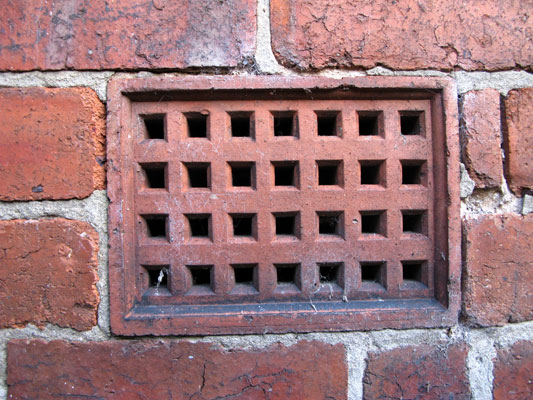Airbrick
An airbrick is a special type of brick that contains holes to allow the circulation of 'fresh' outside air beneath suspended floors and within cavity walls to prevent moisture building up as a result of cold or damp air ‘sitting’ in voids or empty spaces.
Airbricks have traditionally been manufactured using clay or cast iron. Some modern airbricks are made from plastic which can be more durable and enable a greater rate of airflow. An alternative to airbricks is the use of cast iron grilles, known as air vents.
In addition to helping prevent damp and rot setting in to timber floorboards, airflow can be required to provide ventilation for solid fuel fires, stoves, gas heaters, and so on.
Airbricks should be located and installed so as to maximise the cross ventilation in the underfloor voids, and should be kept clear of obstructions. A consideration when installing a conservatory is that airbricks on the wall of the house can be blocked by the conservatory structure or by vegetation, earth, and so on. Similar care must be taken when constructing extensions, to ensure that ventilation air paths are not obstructed, or that alternative air paths are provided.
Airbricks can be positioned either above or below the damp proof course (DPC) level, and should ideally be incorporated on all sides of a building, typically at least 75 mm above the ground to prevent water ingress.
A disadvantage of using airbricks is that the small holes can allow pests such as mice, slugs, and wasps to enter a building. A possible solution is to fix wire mesh over the airbricks, or use specially-made airbrick covers, which can prevent entry of pests.
NB Weep holes are openings placed in mortar joints of facing materials at the level of flashing, to permit the escape of moisture, or openings in retaining walls to permit water to escape. For more information see weep holes.
[edit] Find out more
[edit] Related articles on Designing Buildings Wiki
Featured articles and news
RTPI leader to become new CIOB Chief Executive Officer
Dr Victoria Hills MRTPI, FICE to take over after Caroline Gumble’s departure.
Social and affordable housing, a long term plan for delivery
The “Delivering a Decade of Renewal for Social and Affordable Housing” strategy sets out future path.
A change to adoptive architecture
Effects of global weather warming on architectural detailing, material choice and human interaction.
The proposed publicly owned and backed subsidiary of Homes England, to facilitate new homes.
How big is the problem and what can we do to mitigate the effects?
Overheating guidance and tools for building designers
A number of cool guides to help with the heat.
The UK's Modern Industrial Strategy: A 10 year plan
Previous consultation criticism, current key elements and general support with some persisting reservations.
Building Safety Regulator reforms
New roles, new staff and a new fast track service pave the way for a single construction regulator.
Architectural Technologist CPDs and Communications
CIAT CPD… and how you can do it!
Cooling centres and cool spaces
Managing extreme heat in cities by directing the public to places for heat stress relief and water sources.
Winter gardens: A brief history and warm variations
Extending the season with glass in different forms and terms.
Restoring Great Yarmouth's Winter Gardens
Transforming one of the least sustainable constructions imaginable.
Construction Skills Mission Board launch sector drive
Newly formed government and industry collaboration set strategy for recruiting an additional 100,000 construction workers a year.
New Architects Code comes into effect in September 2025
ARB Architects Code of Conduct and Practice available with ongoing consultation regarding guidance.
Welsh Skills Body (Medr) launches ambitious plan
The new skills body brings together funding and regulation of tertiary education and research for the devolved nation.
Paul Gandy FCIOB announced as next CIOB President
Former Tilbury Douglas CEO takes helm.
UK Infrastructure: A 10 Year Strategy. In brief with reactions
With the National Infrastructure and Service Transformation Authority (NISTA).























